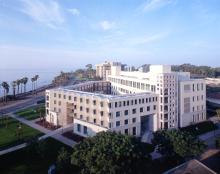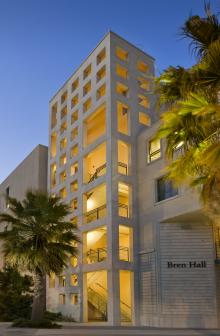
UCSB's Bren Hall Is Nation's First Building to Earn ‘Double Platinum' Rating for Sustainability

Bren Hall, which houses the Bren School of Environmental Science & Management at UC Santa Barbara, has become the nation's first building to earn two LEED Platinum certifications, the highest sustainability rating possible, from the U.S. Green Building Council (USGBC).
On Aug. 4, Bren Hall received a Platinum certification for Existing Buildings
––
Operations & Maintenance. The certification comes seven years after Bren Hall opened in 2002 as the greenest laboratory facility in the nation, and the first to be certified Platinum for New Construction by the USGBC's LEED (Leadership in Energy and Environmental Design) Green Building Rating System. The LEED program has since become the nationally accepted benchmark for the design, construction, and operation of the world's most energy-efficient and high-performing buildings.
"This is tremendous news," said Bren School Acting Dean John Melack. "It was a major achievement to construct Bren Hall as the first LEED Platinum laboratory building in the nation, but in some ways that was easier than earning recertification at the Platinum level. As a new building, much of the work is left to the architects and the contractors, but as an existing building, it is up to us, the occupants, to work with staff and university personnel to maintain and operate the building to the highest standards. This new certification, the result of a months-long process that involved more than a dozen people, demonstrates that we have succeeded in that collaborative endeavor."
UCSB Chancellor Henry T. Yang said: "I am so proud of our Bren School and the many people at this university who make such an achievement possible. I am excited by this recognition, which raises the bar on our already ambitious campus-wide sustainability efforts, and I'm delighted to see that Bren Hall was able to successfully utilize credits earned as part of an innovative LEED pilot program intended to simplify the certification process for institutions."
The chancellor was referring to the USGBC "Portfolio Program," which is intended to streamline the LEED application process for universities, government agencies, and other large institutions by providing shared credits for groups of buildings. UCSB is one of only three institutions invited by the USGBC to participate in the pilot program, in which LEED may grant credits to groups of buildings that have sustainability strategies in common, such as using recycled water, purchasing green janitorial products, and installing energy-efficient lighting. UCSB has designated 25 buildings on campus for future LEED certification. Thanks to the Profile Program, each will begin the application process with 29 of these shared, "pre-approved" credits.
The USGBC awards LEED sustainability credits for everything from construction materials and landscaping to purchasing policies, energy efficiency, air quality, and the health and safety of occupants. The total number of credits determines whether a building receives a rating of certified, silver, gold, or, at the top of the scale, platinum.
New construction (LEED NC) certification includes credits for many elements that are part of putting up a building, such as location, materials used, and management of construction-related waste, as well as credits for resource efficiency and operational elements. Certification for existing buildings (LEED EB) is based on operation and maintenance, occupant health, and financial return of the initial investment in sustainability technology and strategies, so it serves to test the commitment to sustainable operation demonstrated by a building's occupants.
"As the first project to receive LEED Platinum certification as both a new and existing building, Bren Hall demonstrates tremendous green building leadership," said Rick Fedrizzi, president, CEO & founding chair of the U.S. Green Building Council.
"The urgency of the USGBC's mission has challenged the industry to move faster and reach further than ever before, and Bren Hall serves as a prime example with just how much we can accomplish."
The latest LEED certification for Bren Hall was based on how the building fared during a three-month "performance period," when all of the relevant documentation was generated, explained Jordan Sager, LEED program manager at UCSB's Physical Facilities, and a Bren alumnus. At one point in the process, he said, an energy model was run, which showed that Bren Hall's energy use is one-third to one-half that of similar buildings of similar function.
No major retrofitting to Bren Hall was undertaken to obtain the Platinum certification, Sager noted, adding that most of the work was "no cost or low cost." The biggest changes were an upgrade of the already energy-efficient laboratory fume hoods and the purchase of 2 million megawatt hours of renewable wind and solar energy credits. The building received the maximum amount of credits possible for energy efficiency.
Related Links
Bren School of Environmental Science & Management
U.S. Green Building Council



